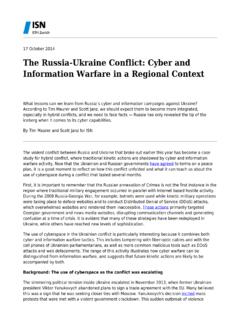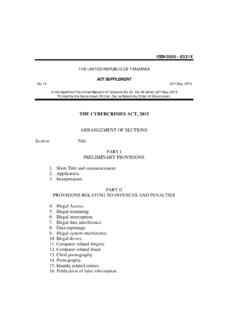Transcription of DIRECTIVE OF THE EUROPEAN PARLIAMENT AND OF THE …
1 EUROPEAN . COMMISSION. Strasbourg, COM(2022) 105 final 2022/0066 (COD). Proposal for a DIRECTIVE OF THE EUROPEAN PARLIAMENT AND OF THE COUNCIL. on combating violence against women and domestic violence {SEC(2022) 150 final} - {SWD(2022) 60 final} - {SWD(2022) 61 final} - {SWD(2022) 62 final} - {SWD(2022) 63 final}. EN EN. EXPLANATORY MEMORANDUM. 1. CONTEXT OF THE PROPOSAL. Reasons for the proposal The current proposal aims to effectively combat violence against women and domestic violence throughout the EU. It does so by proposing measures in the following areas: the criminalisation of and sanctions for relevant offences; protection of victims and access to justice; victim support; prevention; coordination and cooperation.
2 violence against women is gender-based violence directed against a woman because she is a woman or that affects women disproportionately. It includes all acts of gender-based violence that result in or are likely to result in physical, sexual, psychological or economic harm or suffering, including threats of such acts. It encompasses offences such as sexual violence , including rape, female genital mutilation, forced marriage, forced abortions or sterilisation, human trafficking for the purposes of sexual exploitation, stalking, sexual harassment, femicide, hate speech and crimes on the basis of sex and various forms of online violence ( cyber violence '), including non-consensual sharing or manipulation of intimate material, cyber stalking and cyber harassment.
3 Such violence is rooted in gender inequality being a manifestation of structural discrimination against women. Domestic violence is a form of violence against women as it disproportionately affects women. It occurs in the family or domestic unit, irrespective of biological or legal family ties, either between intimate partners or between other family members, including between parents and children. Women are disproportionately represented as victims of both forms of violence due to the underlying patterns of coercion, power and/or control. However, anyone can be a potential victim of such violence , regardless of their sex or gender. In the case of domestic violence , in particular, it can affect any person, including men, younger or older people, children and LGBTIQ1.
4 Persons. violence against women and domestic violence are matters of criminal law, violations of human rights and forms of discrimination. Combating them is part of the EUROPEAN Commission's action to protect the core EU values and to ensure that the EU Charter on Fundamental Rights is upheld2. violence against women and domestic violence are pervasive throughout the EU and are estimated to affect 1 in 3 women in the EU. Looking at the more specific types of violence , in 2014, 1 in 10 women reported that they had been victim of sexual violence and 1 in 20 had been raped. More than 1 in 5 women have suffered domestic violence3. cyber violence is just as prevalent: in 2020, it was estimated that 1 in 2 young women experienced gender-based 1.
5 Lesbian, gay, bisexual, trans, non-binary, intersex, queer. 2. violence against women and domestic violence can affect numerous of the fundamental rights enshrined in the Charter of Fundamental Rights of the EUROPEAN Union. These rights include the right to human dignity (Article 1), the right to life (Article 2), the prohibition of torture and inhuman or degrading treatment (Article 4), the right to freedom from discrimination, including on the grounds of sex (Article 21) and the right to access justice (Article 47). 3. EUROPEAN Union Agency for Fundamental Rights (FRA), violence against women: an EU-wide survey. Main results report, 2014; The FRA survey on violence against women is based on face-to-face interviews with 42,000.
6 Women across the EU. The survey presents the most comprehensive survey worldwide on women's experiences of violence . EN 1 EN. cyber violence4. Women in general, more frequently experience cyber violence based on their sex or gender, in particular sexual forms of cyber violence . Women are systematically targeted online by violent right wing extremist groups and terrorist groups intending to spread hatred against them. The so-called incel' (involuntary celibate) movement, for instance, incites to violence against women online and promotes such violence as heroic acts. cyber violence particularly impacts women active in public life, such as politicians, journalists and human rights defenders.
7 This can have the effect of silencing women, hindering their societal participation and undermining the principle of democracy as enshrined in the Treaty on EUROPEAN Union. Women also experience violence at work: about a third of women in the EU who have faced sexual harassment experienced it at work. President von der Leyen's political guidelines highlighted the need to prevent and combat violence against women, protect victims and punish offenders as a key priority for the Commission. The Gender Equality Strategy 2020-20255 announced EU measures to prevent these forms of violence , protecting victims, prosecuting offenders, and implementing related comprehensive and coordinated policies.
8 The EUROPEAN Pillar of Social Rights Action Plan reiterates the commitment to combat gender-based violence and propose legislation to this effect6. The EUROPEAN PARLIAMENT has repeatedly called on the Commission to propose legislation on violence against women and domestic violence , and on gender-based cyber violence . The EUROPEAN PARLIAMENT most recently has adopted two own-initiative legislative reports based on Article 225 Treaty on the Functioning of the EUROPEAN Union (TFEU), requesting the Commission7 to submit proposals on combating gender-based violence and cyberviolence8. and on adding gender-based violence as a new area of crime listed in Article 83(1) of the TFEU9, respectively.
9 Objectives of the proposal This proposal aims to prevent and combat violence against women and domestic violence to ensure a high level of security and the full enjoyment of fundamental rights within the Union, including the right to equal treatment and non-discrimination between women and men. The proposal thus contributes to the establishment of an area of freedom security and justice (Title V TFEU). To achieve these objectives, the proposal: makes the current EU legal instruments relevant to combating violence against women and domestic violence more effective;. creates upwards convergence and fills gaps in protection, access to justice, support, prevention and coordination and cooperation; and aligns EU law with established international standards.
10 4. EUROPEAN Parliamentary Research Service (EPRS), Combating gender-based violence : Cyberviolence, EUROPEAN added value assessment, 2021. 5. COM/2020/152 final. 6. COM/2021/102 final. 7. Referring to Article 225 TFEU. 8. Resolution of 14 December 2021 with recommendations to the Commission on combating gender based violence : cyber violence , (2020/2035(INL)). 9. Resolution of 16 September 2021 with recommendations to the Commission on identifying gender-based violence as a new area of crime listed in Article 83(1) TFEU (2021/2035(INL)). EN 2 EN. The proposal criminalises certain forms of violence that disproportionately affect women and strengthens victims' rights, using the existing legal bases as set out in Articles 82(2) and 83(1).














